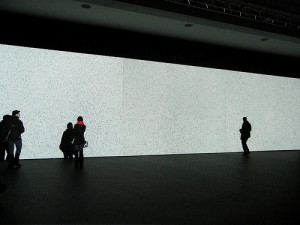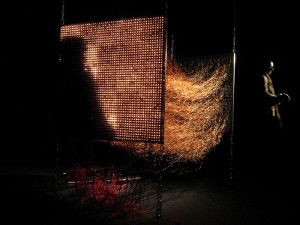The 2010 edition of Transmediale, Berlin’s renowned contemporary arts and digital-culture festival, took place under the title ‘Futurity Now’.

data.tron (3 SXGA+ version). Lucy Benson Image
In exploring the significance of the Now in this title, the point of agreement amongst the gathered artists, academics, creative industry professionals, scientists and technologists was that our concept of the future defines our experience of the present. By working together to build our image of the future we can provide ourselves with the direction needed for living in the now.
In discussing future-image building we arrive quickly at the concept of speculation, a practice borrowed from sciences and heavily utilized by artists, albeit with a nostalgic tendency, in the festival’s showcase exhibition, Futura Obscura. The exception here was Ryoji Ikeda’s arresting installation data.tron [3 SXGA version] (2007-9) an immense and entirely futuristic wall of black and white visual data, mathematically composed and accompanied by a simple electronic soundtrack.

'A Parallel Image'. Lucy Benson Image
A Parallel Image (2009) by Gebhard Sengmüller, one of the most beautiful works on display, was built on the premise that the modern technique of electronically transmitting images by breaking them down into smaller parts had not been developed, instead offering us a direct pixel-by-pixel transmission using LED’s and a sea of glistening copper cables. Panoramic Wifi Camera (2010) derived from the question; is it possible to make a camera that detects wireless signals? This raises the point that in an ever-increasingly technological world, artists wishing to examine the nature of their environment must themselves employ ever-increasingly technological methods, whether in collaboration with a scientific team or though their own initiative. As was the case with Elektrolab, artists Rachida Ziani and Dewi de Vree explored the basics of electrical conduction to build a series of oversized battery systems (copper and zinc elements submerged in an ionic solution) and manipulated the resulting output to drive a sound performance.
Economic speculation was also a key topic at Transmediale 10, with a large proportion of the seminars based on the financial sustainability of the creative industries. I was surprised at this heavy focus on industry and market, but it did give rise to some interesting discussions. Adam Somlai-Fischer, founder of the Kitchen Budapest medialab, provided some inspiration by detailing the group’s highly successful collaboration with Hungary’s major telecom company. There was also much discussion around the value of collaborative community workspaces, such as Berlin’s Betahaus project, with moderator Bas Van Heur going so far as to declare ‘the future is all about collaboration and co-working’.
In his opening address, Transmediale’s artistic director Stephan Kovats explained the term Futurity as the qualitative nature of future as a concept, or to simplify, the essence of the future. He went on to admit it was a difficult theme to tackle because of the immediate clichés and trends it suggests.
While I think these were mostly avoided at the festival, I was left feeling that Transmediale could have afforded to be a little more forward-thinking in terms of the works on display and the overall positioning of the event.
Lucy Benson
Lucy Benson is a media artist and designer currently located between Berlin and Zurich. She was a 2009 recipient of the Ian Potter Cultural Trust for further study.
Read More
http://www.transmediale.de/en/node/12135 - Collaborative Futures, published by Transmediale
Watch More
Transmediale Stream: Andy Cameron introduces the Creativity as an Economic Research Session
Transmediale Stream: Adam Somlai Fischer (hu) on Creativity as an Economic Resource
 This work is licensed under a Creative Commons Attribution-NonCommercial-ShareAlike 2.5 Australia.
This work is licensed under a Creative Commons Attribution-NonCommercial-ShareAlike 2.5 Australia.






